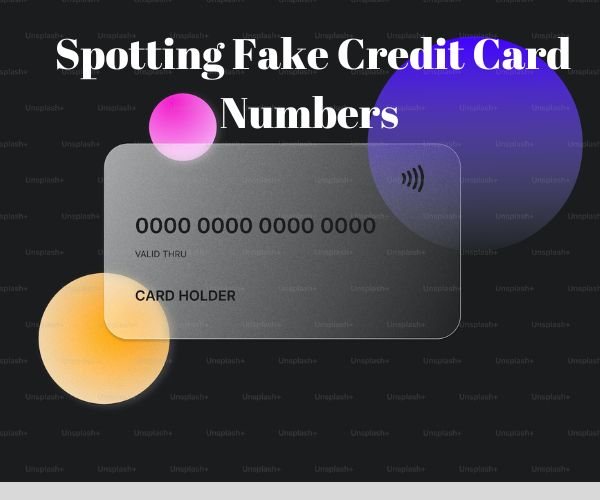Spotting Fake Credit Card Numbers
Criminals have discover a ways to generate fake credit card numbers that can actually work for illicit purposes. It’s essential for individuals and businesses to stay vigilant and learn how to identify these fake credit card numbers to protect themselves from fraud and financial loss. In this article, we will discuss the world of fake credit card numbers, providing you with valuable insights on how to spot out fake credit card numbers that work.
Credit Card Issuer Algorithms
Looking At Credit Card Number Composition
Different parts of the 16-digit credit card number mean different things and follow certain patterns. For starters, credit card numbers typically start with a 4 or a 5—this is known as the Major Industry Identifier (MII). The MII of 4 indicates the card is issued by a banking or financial institution, while a 5 indicates the card is issued by a banking and financial institution.
Issuer Identification Number
Moving on to the first 6 digits, these constitute the Issuer Identification Number (IIN), formerly known as the bank identification number (BIN). These numbers identify the institution that issued the card to the cardholder. The remaining digits all the way until the last one have varying meanings, depending on the card issuer. They could possibly represent the account number of the cardholder, issue identifier, or other specifics the issuing bank may use for its customers.
The Importance of the Check Digit
The final digit of the credit card number is known as a check digit. It is derived from a mathematical formula, the Luhn algorithm, applied to the preceding digits. This redundancy check is performed whenever a credit card number is manually entered, as a quick way to check for simple errors or potential fraudulent numbers.
Initiating the Luhn Algorithm
The Luhn algorithm, or Luhn formula, also known as the “modulus 10” or “mod 10” algorithm, is a simple checksum formula used to validate a variety of identification numbers, but most notably credit card numbers. Here’s a basic rundown of how it works:
- Double the value of every second digit from the rightmost (check digit).
- If doubling of a number results in a two digits number, add the digits to get a single digit number.
- Now, add all single-digit numbers from step 1 and all digits in the odd places from the right.
- If the total modulo 10 equals 0 (if the total ends in zero) then the number is valid according to the Luhn formula, otherwise it’s not.
Verifying a Valid Credit Card Number
When the total sum of the credit card number is divided by 10, the result should be a whole number (i.e., there should be no remainder or fractional part). If this is not the case, the card is likely fraudulent, as it does not adhere to industry-wide standards.
Note that this system only checks the validity of the number format, not the credit card itself. It does not guarantee that the credit card is active or has credit, or that the number has not been stolen.
Mastering Luhn Algorithm
Understanding the Structure of Credit Card Numbers
Every credit card number is unique, but they follow a standard format. The first six digits are the Issuer Identification Number (IIN), which tells you which banking institution the card belongs to. The following 6 to 9 digits are the individual account number, and the last digit is a checksum. The checksum is a value that is calculated from the other numbers. If the checksum doesn’t match the expected value, then the number is likely a fake.
Grasping the Luhn Algorithm
The Luhn algorithm is a widely-used method for validating unique identification numbers, including credit card numbers. The process involves doubling every second digit from the right and subtracting 9 from any product that is greater than 9. Add all the numbers together. If the result is divisible by 10, then the card number could be valid.
Mastering the Luhn Algorithm: Step-by-Step Guide
Step 1: From the rightmost digit (excluding the check digit) and moving left, double the value of every second digit. For example, if your card number is 123456781234567, you would double the values of 7, 4, 1, 6, 3, and 0.
Step 2: Subtract 9 from any number that is now greater than 9.
Step 3: Add all the untouched digits and the remaining doubled digits together.
Step 4: The total from step 3 must be a multiple of 10 for it to be a valid credit card number.
For example, let’s take a fake credit card number 1234567812345670. Following the steps:
Step 1: Doubling the every second digit, we get 2, 4, 6, 8, 1, 3, 5, 7, 2, 4, 6, 7.
Step 2: None of the values is over 9, so we don’t subtract anything here.
Step 3: Adding these numbers up gives 60.
Step 4: Since 60 is a multiple of 10, the credit card number would pass the Luhn algorithm and could possibly be a genuine credit card number.
Keep in Mind
The Luhn algorithm only validates the mathematical integrity of a card number’s composition; it does not confirm if the card is real or active. A card can have a number that passes the Luhn check but still be a fake or inactive. Therefore, identifying fake credit card numbers is not entirely foolproof using this method only, but it’s a crucial first step in the validation process. Other industry processes, like card authentication and authorization procedures, are performed to further confirm authenticity.
Recognizing Fake Credit Card Number Generators
Recognize the Online Availability
Fake credit card number generators are widely available on the internet. These online tools might seem legitimate at first glance due to their professional-looking websites. However, their existence to create and distribute fake credit card numbers can be a significant red flag. Various regulations strictly prohibit the creation and use of fraudulent credit card details, indicating that such services might not be credible or lawful.
Identify the Characteristic of Fake Credit Card Numbers
Spotting Fake Credit Card Numbers
Fake credit card numbers might appear identical to real ones at first sight because they often contain the same number of digits as authentic ones and might even start with the same few digits. However, on closer examination, one can distinguish a few significant differences. Fake credit card numbers often lack the personal details associated with authentic cards, such as the cardholder’s name, expiration date, and CVV. Another common characteristic is the inability of these fake numbers to pass through any card validation process, such as the Luhn Check, a mathematical algorithm used to validate a variety of identification numbers.
Understand the Typical Output
One of the main features of fake credit card number generators is their typical output. These generators often provide numbers in bulk, rather than a single number that an actual credit card company would issue. Most commonly, these numbers follow no logical sequence or pattern, which is a stark contrast to the structured methods used by legitimate credit card issuers. Notably, these fake numbers often do not match with any issuing bank or institution, a clear sign of their fraudulent nature.
Know How They Function
A general understanding of how these generators operate can aid in identifying fake credit card numbers. Most of these generators use mathematical algorithms such as the Luhn Algorithm but miss out on other critical processes present in legitimate card issuing. They usually generate sets of numbers that resemble a credit card number’s structure but fail to incorporate other essential features such as issuer identification number (IIN) or account number.
Recognizing the Ineffectiveness in Real Transactions
Fake credit card numbers that work are a misleading term. While these numbers might ‘work’ in the sense that they bypass initial validation oftentimes, they are ineffective for actual transactions. This recognized inability is due to these numbers not being tied to any actual bank account or real-life source of funds. An immediate error or denial message when attempting to conduct a transaction is a clear sign of a fake credit card number.
Overall, to identify fake credit card numbers that work, it’s vital to understand their online availability, characteristics, typical output, functioning, and ineffectiveness in real transactions.
Practical Application and Case Studies
Identifying Fake Credit Card Numbers
Understanding the makeup of a genuine credit card number can assist professionals like you in identifying fake credit card numbers. All credit card numbers should follow the Luhn formula, also known as the Luhn algorithm or Modulus 10. Devised by IBM scientist Hans Peter Luhn in the 1960s, this mathematical formula is universally adopted by all credit card companies.
Here’s how you can apply the Luhn check:
- Begin from the rightmost number – the check digit – and double the value of every second digit.
- If doubling a digit results in a number greater than 9, subtract 9 from it.
- Sum all the numbers obtained in steps 1 and 2.
- If the total modulo 10 equals 0, then the number is valid according to the Luhn formula. If not, it is a fake credit card number.
The Massive Fake Credit Card Scheme
A major case study of credit card fraud was the Federal bust in 2013 which involved 13 different criminal rings in and around New York City. The FBI and local law enforcement shut down this massive scheme that used thousands of fake credit card numbers to steal over $200 million.
The criminals had created around 7,000 fake identities to acquire over 25,000 credit cards. While the credit card numbers on these cards were technically ‘valid’ as per the Luhn algorithm, they were connected to fake identities and fraudulent accounts.
Their modus operandi was to build up the creditworthiness of these fake identities, known as “synthetic identities,” by maintaining regular operations on these accounts and regularly paying off debts. This elevated the credit limits on these accounts, allowing them to borrow massive amounts of money which they had no intention of repaying.
Pattern Recognition and Preventive Measures
From this, we can identify certain patterns and strategies employed by fraudsters. Their methods were sophisticated but not foolproof. These fake accounts were given away by patterns of suspicious activity, such as multiple accounts linked with the same mailing addresses or telephone numbers, and unusual purchasing or withdrawal behaviors.
Professionals can apply this knowledge in practical simulations. Observations and correlations of data can reveal insights, like frequent transactions of round-sum figures, abrupt changes in billing cycle, or sudden spikes in activity, which may signify fraudulent activity.
Moreover, professionals can employ robust identity verification methods to confirm the legitimacy of credit card holders. Measures can include multi-factor authentication, security questions, biometric data, and AI algorithms that use machine learning to detect anomaly patterns.
Frequently Asked Questions
Are fake credit card numbers common?
Fake credit card numbers are relatively common, especially in the world of online fraud. Staying informed about how to identify them is essential for your security.
Can fake credit card numbers be used for purchases?
In some cases, fake credit card numbers may work for a short time, but they are illegal to use and will lead to legal consequences.
What should I do if I suspect a fake credit card number?
If you suspect a credit card number is fake, do not accept payment or process any transactions. Contact your payment processor or bank for guidance.
Are there any online tools to verify credit card numbers?
Yes, there are online tools and databases that can help verify the legitimacy of credit card numbers. Always use reputable sources for verification.
How can businesses protect themselves from fake credit card numbers?
Businesses should implement robust fraud detection and prevention measures, including real-time verification of credit card information and monitoring for suspicious activity.
Conclusion
By understanding the common patterns of fraudsters and applying this awareness in practical simulations, professionals can help reduce the risks and impact of such credit card scams.
With this discourse as a robust foundation, one can readily delve into real-world applications, scrutinizing and analyzing case studies related to previously identified frauds. By doing so, one can discern common patterns and techniques employed by fraudsters. Recognizing the prevalence of fake credit card number generators and their characteristics also plays an essential role in this process. Through the rigorous and continual study of these key areas, one transforms from a mere spectator to an active agent armed with the knowledge to distinguish between genuine and fraudulent credit card numbers, thereby fostering a more secure and trustworthy financial environment.










